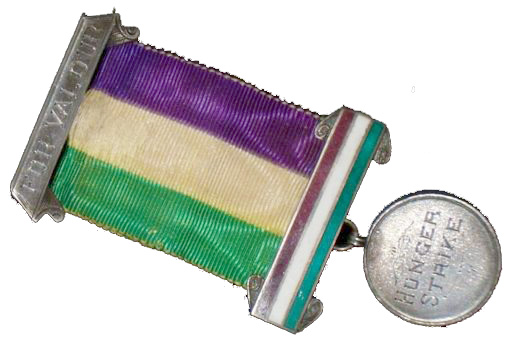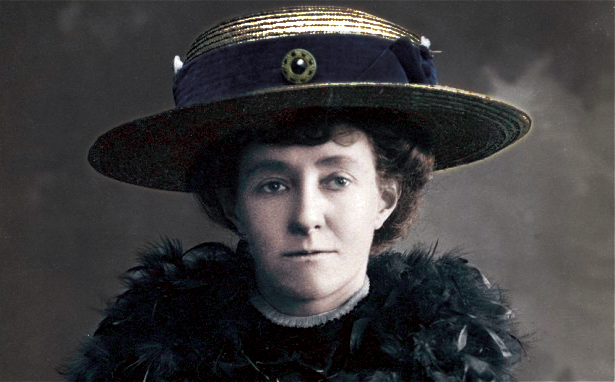1906 On 30th November, Emily joined the Women’s Social and Political Union (WSPU).
1907 Left employment as live-in Governess in Spratton. Took part in her first WSPU march
1908 Emily was awarded a first class honours pass in English Language and Literature from the Royal Holloway, but once again, because she was a woman she was unable to be awarded a degree. Emily quit teaching to work for the WSPU full-time. On 21st June she served as a chief Steward at WSPU Women’s Sunday Rally in Hyde Park.
1909 On 30th March, Emily was imprisoned for one month for being part of a deputation of 21 women who marched from Caxton Hall to see Prime Minister Asquith. There was a fracas and she was arrested for assaulting the police. After her release, she wrote to Votes for Women, the WSPU newspaper, saying that “Through my humble work in this noblest of all causes I have come into a fullness of job and an interest in living which I never before experienced”. On 30th May she was imprisoned for two months for obstruction. Then on 30th July, she was imprisoned for two months for obstruction at Lime house, London. Released after 5 1/2 days hunger strike, during which time she lost 21 pounds (9.5 kilos). She had been arrested with fellow suffragettes Mary Leigh and Alice Paul for interrupting a public meeting from which women were barred, which was held by the Chancellor of the Exchequer, David Lloyd George. On 4th September, Emily was imprisoned for two months for throwing stones and breaking windows at a political meeting at White City, Manchester, which only admitted men. She was sent to Strangeways Prison but was released after 2 1/2 days of hunger strike. She subsequently wrote to the Manchester Guardian that her actions, ”were meant as a warning to the general public of the personal risk they run in future if they go to cabinet minister’s meetings anywhere”. She went on to justify this because of the “unconstitutional action of cabinet ministers in addressing ‘public meetings’ from which a large section of the public is excluded”.
On 20th October, she was sentenced to Stangeways again for one month’s hard labour for throwing a stone at a ministerial car at a political meeting at Radcliffe, Greater Manchester. She mistakenly believed that the cabinet minister, Sir Walter Runciman was Lloyd George. She was released after eight days, during which time she went on hunger strike. She was then force-fed for the first time. Emily said that the experience, “will haunt me with its horror all my life, and is almost indescribable…the torture was barbaric”. To prevent a repeat of the experience, she barricaded herself in her cell using her bed and a stool and refused to allow the prison authorities to enter. They broke one of the windowpanes of the cell and turned a fire hose on her for 15 minutes, while attempting to force the door open. By the time they succeeded the cell was six inches deep in water. She was taken to the prison hospital and warmed with hot water bottles. She was then again force-fed shortly after and released eight days later. She went on to successfully sue the prison.

1910 In January, Emily was awarded 40 shillings compensation for the hose incident. In April, Emily became an employee of the WSPU and began to write for Votes for Women. Emily decided to try to gain entry to the floor of the House of Commons to ask Asquith about giving the vote to women, She entered the Palace of Westminster with other members of the public and made her way into the heating system, where she hid overnight. However, on a trip from her hiding place to find water, she was discovered and arrested, but not prosecuted. On 29th June, Emily was arrested on the great deputation with Mrs Emmeline Pankhurst. In July, she took part in another WSPU march. 19th November was known as ‘Black Friday’. Emily was not there but was incensed at the treatment of her fellow suffragettes by the police and went on to break several windows in the Crown Office in Parliament in protest. She was arrested and sentenced to a month in prison. She went on hunger strike, was force-fed and released after eight days.
1911 On 2nd April she hid overnight in a broom cupboard in St. Mary Undercroft, the chapel of the Palace of Westminster. She stayed overnight to avoid being listed in the census. She was found by a cleaner, who reported her. Emily was arrested but not charged. The Clerk of Works at the House of Commons completed a census form to include Emily in the returns. However, she was included twice, as her landlady also included her as being present at her lodgings .In June, Emily took part in a WSPU march. She also hid in the crypt at the Houses of Parliament again. In July she took part in a WSPU march. On 14th December, Emily was sent on remand to Holloway Prison for a week for setting fire to pillar-boxes in the City of Westminster.
1912 On 10th January, Emily was sentenced at the Old Bailey and imprisoned for six month for the above offence. She subsequently went on hunger strike twice and was force-fed twice. She was released 10 days before completing the sentence due to injuries sustained during a protest made against force-feeding of other suffragettes. On 29th February, despite not going on hunger strike, Emily was force-fed for seven days because the authorities considered her health and appetite to be in decline. During this time in Holloway Prison she wrote the poem L’Envoi which was the last poem in the Holloway Jingles a collection of poems by other suffragette prisoners. In June, along with other suffragette inmates, Emily barricaded herself into her cell and went on hunger strike. The authorities broke down the cell doors and force-fed the strikers. Following this, Emily decides on what she described as a “desperate protest… made to put a stop to the hideous torture, which was now our lot”, and jumped from one of the interior balconies of the prison. She cracked two vertebrae and badly injured her head. Shortly afterwards, and despite her injuries, she was again force-fed before being released ten days early. As a result of her action, Emily suffered discomfort for the rest of her life. On 30th November, Emily was sentenced to 10 days in prison for assaulting a Baptist minister with a horsewhip, at Aberdeen Station, whom she mistook for Mr. Lloyd George. She went on hunger strike and was released four days early.

